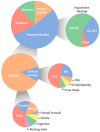Ten Key Insights into the Use of Spinal Cord fMRI
- PMID: 30201938
- PMCID: PMC6162663
- DOI: 10.3390/brainsci8090173
Ten Key Insights into the Use of Spinal Cord fMRI
Abstract
A comprehensive review of the literature-to-date on functional magnetic resonance imaging (fMRI) of the spinal cord is presented. Spinal fMRI has been shown, over more than two decades of work, to be a reliable tool for detecting neural activity. We discuss 10 key points regarding the history, development, methods, and applications of spinal fMRI. Animal models have served a key purpose for the development of spinal fMRI protocols and for experimental spinal cord injury studies. Applications of spinal fMRI span from animal models across healthy and patient populations in humans using both task-based and resting-state paradigms. The literature also demonstrates clear trends in study design and acquisition methods, as the majority of studies follow a task-based, block design paradigm, and utilize variations of single-shot fast spin-echo imaging methods. We, therefore, discuss the similarities and differences of these to resting-state fMRI and gradient-echo EPI protocols. Although it is newly emerging, complex connectivity and network analysis is not only possible, but has also been shown to be reliable and reproducible in the spinal cord for both task-based and resting-state studies. Despite the technical challenges associated with spinal fMRI, this review identifies reliable solutions that have been developed to overcome these challenges.
Keywords: analysis; animal; fMRI; human; methods; review; spinal cord.
Conflict of interest statement
The authors declare no conflict of interest.
Figures





Similar articles
-
Multi-shot acquisitions for stimulus-evoked spinal cord BOLD fMRI.Magn Reson Med. 2021 Apr;85(4):2016-2026. doi: 10.1002/mrm.28570. Epub 2020 Nov 10. Magn Reson Med. 2021. PMID: 33169877 Free PMC article.
-
Advances in Spinal Functional Magnetic Resonance Imaging in the Healthy and Injured Spinal Cords.Curr Phys Med Rehabil Rep. 2017 Sep;5(3):143-150. doi: 10.1007/s40141-017-0161-x. Epub 2017 Jul 31. Curr Phys Med Rehabil Rep. 2017. PMID: 29255645 Free PMC article.
-
Spinal cord functional MRI at 3 T: gradient echo echo-planar imaging versus turbo spin echo.Neuroimage. 2008 Nov 1;43(2):288-96. doi: 10.1016/j.neuroimage.2008.07.024. Epub 2008 Jul 23. Neuroimage. 2008. PMID: 18706507
-
Investigating the human spinal sensorimotor pathways through functional magnetic resonance imaging.Neuroimage. 2021 Dec 15;245:118684. doi: 10.1016/j.neuroimage.2021.118684. Epub 2021 Oct 31. Neuroimage. 2021. PMID: 34732324 Review.
-
Applying functional MRI to the spinal cord and brainstem.Magn Reson Imaging. 2010 Oct;28(8):1225-33. doi: 10.1016/j.mri.2010.03.032. Epub 2010 Apr 21. Magn Reson Imaging. 2010. PMID: 20409662 Review.
Cited by
-
Spinal Cord fMRI: A New Window into the Central Nervous System.Neuroscientist. 2023 Dec;29(6):715-731. doi: 10.1177/10738584221101827. Epub 2022 Jul 13. Neuroscientist. 2023. PMID: 35822665 Free PMC article. Review.
-
Automatic segmentation of the spinal cord nerve rootlets.Imaging Neurosci (Camb). 2024 Jul 2;2:imag-2-00218. doi: 10.1162/imag_a_00218. eCollection 2024. Imaging Neurosci (Camb). 2024. PMID: 40800300 Free PMC article.
-
Functional connectivity in the dorsal network of the cervical spinal cord is correlated with diffusion tensor imaging indices in relapsing-remitting multiple sclerosis.Neuroimage Clin. 2022;35:103127. doi: 10.1016/j.nicl.2022.103127. Epub 2022 Jul 27. Neuroimage Clin. 2022. PMID: 35917721 Free PMC article.
-
Human spinal cord activation during filling and emptying of the bladder.Nat Commun. 2025 Jul 15;16(1):6506. doi: 10.1038/s41467-025-61470-1. Nat Commun. 2025. PMID: 40664673 Free PMC article.
-
Spinal Cord Lower Urinary Tract Control in Humans.Neurourol Urodyn. 2025 Jun;44(5):1203-1210. doi: 10.1002/nau.70059. Epub 2025 Apr 30. Neurourol Urodyn. 2025. PMID: 40302398 Free PMC article.
References
Publication types
LinkOut - more resources
Full Text Sources
Other Literature Sources

